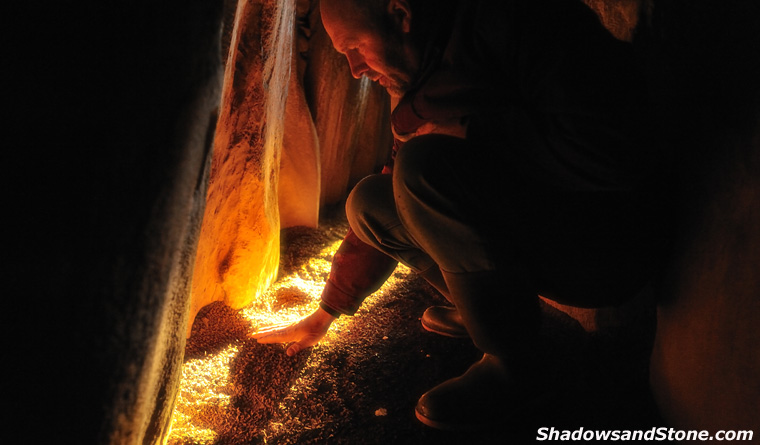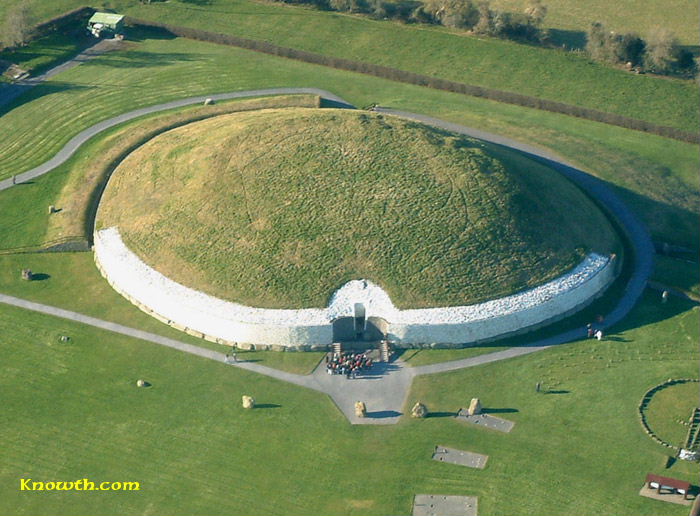Newgrange Megalithic Passage Tomb
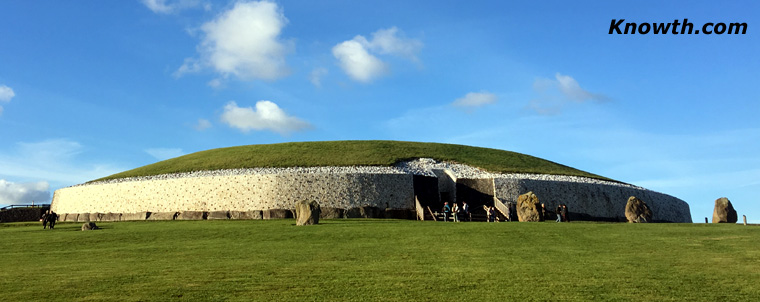
Front view of Newgrange with white quartz facade
The Megalithic Passage Tomb at Newgrange was built about 3,200 BC. The kidney shaped
mound covers an area of over one acre and is surrounded by 97 kerbstones, some of
which are richly decorated with megalithic art. The 19 metre long inner passage
leads to a cruciform chamber with a corbelled roof. It is estimated that the
construction of the Passage Tomb at Newgrange would have taken a work force of 300
at least 20 years.
Winter Solstice
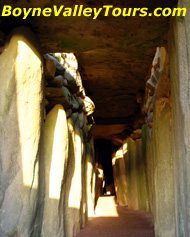 The passage and chamber inside the Newgrange mound is illuminated by the
winter solstice sunrise.
A shaft of sunlight shines through the roof-box over the
entrance and penetrates the 19m (63ft) passage to light up the chamber. The dramatic event lasts for 17 minutes at dawn
on the Winter Solstice and a few mornings either side of the Winter Solstice.
The passage and chamber inside the Newgrange mound is illuminated by the
winter solstice sunrise.
A shaft of sunlight shines through the roof-box over the
entrance and penetrates the 19m (63ft) passage to light up the chamber. The dramatic event lasts for 17 minutes at dawn
on the Winter Solstice and a few mornings either side of the Winter Solstice.
Admission to the Newgrange chamber for the Winter Solstice sunrise is by lottery, application forms are available at the Brú na Bóinne Visitor Centre. About 30,000 applications are submitted annually. In September each year, 50 names are drawn with 2 places awarded to each person drawn.
Megalithic Mounds
Megalithic mounds, like Newgrange, became intertwined with Irish mythology, identified as sídhe or fairy mounds. According to legend, Newgrange was believed to be the residence of Oenghus, the deity associated with love. The Passage Tomb at Newgrange, initially obscured and later unearthed in 1699 during road construction, underwent a significant excavation starting in 1962. The restoration efforts included rebuilding the original sparkling white quartz facade, utilizing stones sourced from the site.World Heritage Site
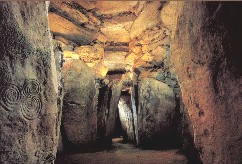 Newgrange has been designated a World Heritage Site by
UNESCO and
attracts 200,000 visitors per year. There is no direct access to the Passage Tomb at
Newgrange, access is by guided tour from the Brú na Bóinne Visitor
Centre located close to the village of Donore, Co. Meath. The last tour of
Newgrange is 90 minutes before closing time of the Visitor Centre. Groups of 15 or more must book in advance.
Newgrange has been designated a World Heritage Site by
UNESCO and
attracts 200,000 visitors per year. There is no direct access to the Passage Tomb at
Newgrange, access is by guided tour from the Brú na Bóinne Visitor
Centre located close to the village of Donore, Co. Meath. The last tour of
Newgrange is 90 minutes before closing time of the Visitor Centre. Groups of 15 or more must book in advance.
Newgrange Images
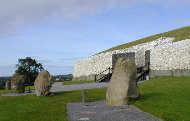 Images of Newgrange, 12 standing stones survive of an estimated 35 stones that once surrounding the monument. The large mound is built of alternating layers of earth and stones and is 85m (279ft) across and 13m (43ft) high, and covers 4,500 sq.m (1 acre) of ground.
Images of Newgrange, 12 standing stones survive of an estimated 35 stones that once surrounding the monument. The large mound is built of alternating layers of earth and stones and is 85m (279ft) across and 13m (43ft) high, and covers 4,500 sq.m (1 acre) of ground.
Newgrange Chamber
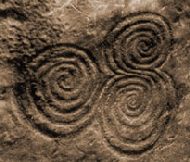 Images
from inside the chamber at Newgrange including the tri-spiral design on orthostat C10
which is probably the most famous Irish Megalithic symbol. It is
often referred to as a Celtic design, but it was carved at least 2500 years before
the Celts reached Ireland. At 12 inches in
diameter the tri-spiral design is quite small in size, less than one-third the size
of the tri-spiral design on the entrance stone.
Images
from inside the chamber at Newgrange including the tri-spiral design on orthostat C10
which is probably the most famous Irish Megalithic symbol. It is
often referred to as a Celtic design, but it was carved at least 2500 years before
the Celts reached Ireland. At 12 inches in
diameter the tri-spiral design is quite small in size, less than one-third the size
of the tri-spiral design on the entrance stone.
Gavrinis
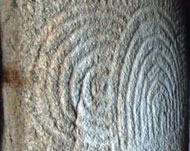 The Gavrinis passage tomb
in Brittany is remarkable similar to Newgrange. The cairn is about
5500 years old, it is 60 metres in diameter and covers a
passage and chamber which is lined with elaborately engraved stones.
The Gavrinis passage tomb
in Brittany is remarkable similar to Newgrange. The cairn is about
5500 years old, it is 60 metres in diameter and covers a
passage and chamber which is lined with elaborately engraved stones.
In the passage and chamber 23 of the 29 upright stones are engraved with zig-zags, concentric circles, herring bones, axes, bows and arrows.
Newgrange - Further Reading
- A Passage to the Afterworld - the story of New Grange adapted from an article first published in the The World Of Hibernia magazine.
- Directions to the Brú na Bóinne Visitor Centre the access point to Newgrange.
- Michael J. O'Kelly who excavated and restored Newgrange.
- Photographs of New Grange by Annaliese Moyer - Insight Photographic.
- Old Photograph of Newgrange and a newspaper report from 1928.
- Newgrange Excavation Report Critique - by Alan Marshall.
- Newgrange Books - factual books and a novel The Spirit Mound.
- Ireland in prehistory - Early Ireland, Megalithic Ireland, Ancient Ireland - Outside Influences.
- Emerald Sun - prologue to the historical novel The Princes of Ireland by Edward Rutherfurd. The prologue sets the scene of ancient Ireland with the winter solstice at Newgrange the centrepiece.
- Newgrange: empowering the salmon of wisdom by Philip Coppens.
- An anthropological lens applied to the early settlers of the Boyne Valley, adapted from a lecture by Dr. Gabriel J. Byrne.
- Messages from the Monuments - How Neolithic Monuments Communicate About Religion and Status by Paul K. Wason.
- Newgrange plans from Michael J. O'Kelly's book Newgrange Archaeology, Art and Legend.
- Newgrange Links - External resource links.
Private Tour to Newgrange, Knowth, and the Boyne Valley
Embark on a journey through time and heritage with our exclusive private tour to Newgrange, Knowth, and other captivating sites nestled in the enchanting Boyne Valley. Immerse yourself in the rich history and mystique of these World Heritage sites, where ancient wonders come to life.Newgrange and Knowth, both designated as UNESCO World Heritage sites, stand as testament to the ingenuity of our ancestors. Dating back over 5,000 years, these Neolithic passage tombs are older than Stonehenge and the Great Pyramids of Giza. Step inside the chambers of Newgrange, where the winter solstice illuminates a narrow passage, casting an ethereal light on the ancient carvings within. Explore Knowth, adorned with megalithic art, and unravel the mysteries of a bygone era.
Visit the megalithic passage tombs at Newgrange and Knowth with the on-site guide. These are UNESCO World Heritage sites so you will be joining others on the official tour. Beyond the renowned Newgrange and Knowth, our private tour takes you on an intimate exploration of lesser-known gems in the Boyne Valley.
Leave the logistics to us as you embark on a stress-free exploration of the Boyne Valley. Our private tours ensure a personalized and comfortable experience from the moment we pick you up at your accommodation to the time we drop you back.
Boyne Valley Private Day Tour
 Immerse yourself in the rich heritage and culture of the Boyne Valley with our full-day private tours.
Visit Newgrange World Heritage site, explore the Hill of Slane, where Saint Patrick famously lit the Paschal fire.
Discover the Hill of Tara, the ancient seat of power for the High Kings of Ireland.
Book Now
Immerse yourself in the rich heritage and culture of the Boyne Valley with our full-day private tours.
Visit Newgrange World Heritage site, explore the Hill of Slane, where Saint Patrick famously lit the Paschal fire.
Discover the Hill of Tara, the ancient seat of power for the High Kings of Ireland.
Book Now
Home
| Newgrange
| Knowth
| Dowth
| Hill of Tara
| Fourknocks
| Loughcrew
| More Places
| Labyrinths
| Local Info
| Art Works
| Articles
| Images
| Books
| Links
| Boyne Valley Tours
| Contact

